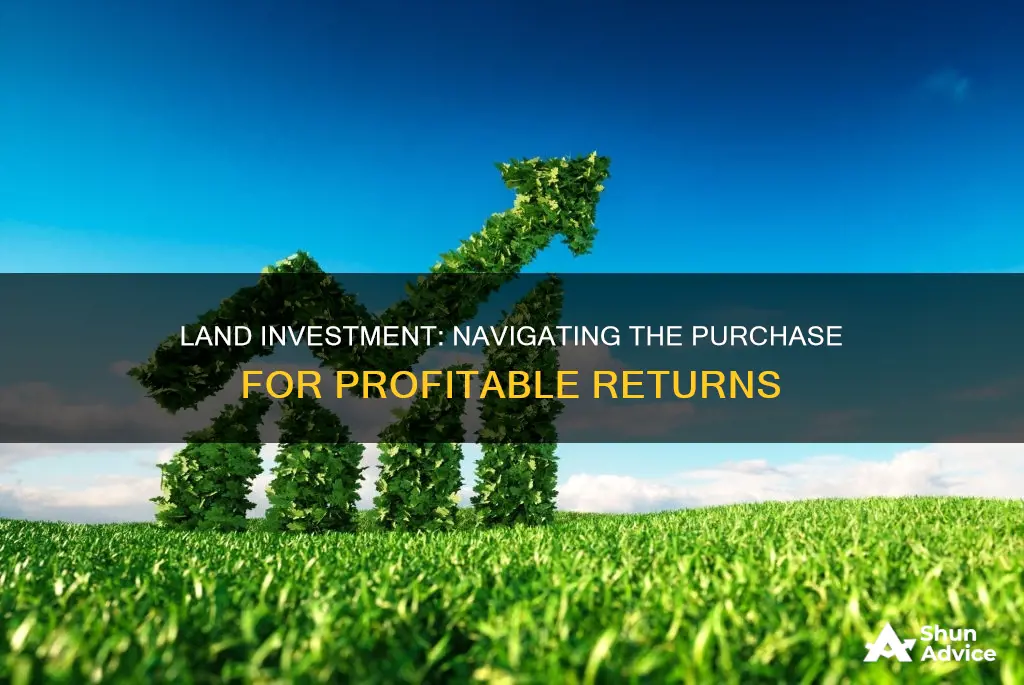
Investing in land is a wise strategic move for investors looking to diversify their portfolios. While it may not be suitable for everyone, it can be a lucrative opportunity for those looking to make good profits.
Land is a tangible asset that is always in demand. With limited supply and increasing population, the demand and cost of land are constantly rising. It is also a less risky investment option compared to stocks as it cannot disappear or lose its value suddenly.
When considering where to buy land for investment, it is important to look at locations with strong density and demographics, ensuring there will always be demand for the land and multiple use types. It is also crucial to understand the zoning laws and permitted uses for the land, as well as access to utilities and the cost of installation.
Additionally, investors should be aware of any restrictions or agreements made with neighbours that may impact the use of the land. Conducting thorough research and due diligence is essential to making a successful land investment.
What You'll Learn

Commercial and residential land
Commercial Land
Commercial land can be a good investment and an excellent way to make money. It can provide an impressive building site and significantly impact your company's finances and future investments. It also offers rental income opportunities and substantial appreciation potential. As the area around the property develops, the land's value can increase, offering substantial returns when it's time to sell.
However, buying commercial land usually requires a bigger initial investment than residential land. Acquiring a commercial property typically requires more capital upfront than a residential rental in the same area. Commercial properties also tend to come with more maintenance issues and costs due to having more customers.
Residential Land
Residential land investments are more likely to generate emotional pricing, and they often come with more consumer protection laws. They are also generally more manageable for a single investor, as they usually involve fewer leases and less maintenance.
However, residential properties typically offer less financial reward than commercial properties. They may also require more of a time commitment from the landlord, as tenants are more likely to require assistance outside of business hours.
Tips for Investing in Commercial Land
- Buy land in the path of development – look for land in up-and-coming areas or in the direction of a municipality's expansion.
- Invest in an asset that requires less attention and expense – undeveloped land requires little to no maintenance and has lower taxes and bills.
- Get pre-approved for a loan – financing can be tricky, especially for first-time investors, as the commercial lending process is much different from loans for residential properties.
- Target vacant land – vacant lots can be eyesores, and a motivated seller may be willing to part with the land at a favourable price.
- Know the zoning and usage laws – check the property's zoning and usage laws before investing to ensure it is zoned for commercial use.
- Do your due diligence – visit the property to understand its topography, and inquire about the availability of utilities and any necessary environmental tests.
- Work with a commercial real estate professional – these transactions are complicated, so it's important to have a pro on your side.
- Use the Buy and Hold strategy – land is a hands-off investment that can increase in value as cities grow and expand.
- Consider vacant land a long-term investment – land purchases tend to require time to gain value and see significant returns.
- Consider alternative ways of using vacant land – lease space to billboard companies, farmers, or hunters while you wait for the land to increase in value.
- Search for land where there is less competition – commercial real estate markets can be crowded with investors, so consider purchasing land further from urban centres, where it will be more affordable.
- Understand the local real estate market – property prices can vary greatly, so it's important to know what you're getting into before making financial decisions.
- Line up your finances and secure a loan – research banks and lenders to learn who does commercial real estate loans for raw land.
- Work with a team of trusted professionals – surround yourself with people who have experience and knowledge to ensure the process is efficient and cost-effective.
- Begin your search – decide what type of commercial land lot you are looking for, e.g. prime commercial, industrial, retail, or development.
- Make wise financial decisions and a solid offer – ensure the offer makes sense for both you and the seller.
Coin Conundrum: Navigating the Smart Investment Puzzle
You may want to see also

Row crop and livestock land
Row crops and livestock land can be a profitable investment, but it requires a good deal of knowledge and capital.
Row crops refer to "land-based commodity" crops such as corn, wheat, barley, oats, and soybeans. These crops are staples in most countries' diets and are used to feed livestock. As such, they are in constant demand, and their value is expected to stand the test of time.
Investing in row crops can be a good way to hedge against inflation and other investments. Since World War II, returns on grain have been uncorrelated to the stock market. Additionally, when the price of processed food rises, the price of the raw materials needed to make that food will also rise.
However, investing in row crops and livestock land is not without its challenges. To be financially viable, the operation needs to be on a very large scale, requiring a significant upfront capital investment. There are also high ongoing fixed costs associated with running these operations, which means that the financial leverage and business risk are very high.
For these reasons, most small investors should avoid pursuing large-scale farming operations. Instead, they can consider investing in agricultural investment options such as funds that provide exposure to traditional farming operations or exchange-traded notes (ETNs) that provide investment exposure to specific types of farming operations.
When considering investing in row crop and livestock land, it is essential to have knowledge of the agricultural industry and real estate. Investors must analyze the market price and performance of the agricultural products the land is designed to produce, as well as the potential returns. It is also crucial to understand the legalities associated with the use of the land, such as land-use restrictions, easements, and mineral rights.
Overall, while row crop and livestock land can be a profitable investment, it is essential to carefully consider the challenges and risks involved and ensure that you have the necessary knowledge and capital to make a successful investment.
The Great Debate: Invest or Pay Off Your Home?
You may want to see also

Mineral rights
In the United States, mineral rights are legally distinct from surface rights. Surface rights give the owner the right to use the surface of the land for residential, agricultural, and commercial purposes. Mineral rights, on the other hand, entitle the owner to own and exploit any natural resources found beneath the land.
When considering buying land for investment, it is important to understand the different types of land investments available and the associated risks and benefits. Mineral rights can be a valuable asset, especially if there are valuable natural resources beneath the land. However, it is important to conduct thorough research and due diligence before investing in land with mineral rights, as there may be legal and environmental considerations that could impact the investment.
Retiree Investments: Unveiling the Unknown Numbers
You may want to see also

Location
When it comes to investing in land, location is a key consideration. Here are some factors to keep in mind when evaluating the location of a potential land investment:
- Market conditions and area growth: It is important to assess the prevailing market conditions and the area's dynamics, such as population growth, economic advancement, and infrastructure development. These factors can impact the demand for land and influence its value over time.
- Zoning laws and regulations: Understanding the zoning laws and regulations that apply to the area is crucial. They specify how the land can be used and developed, and they can vary from region to region.
- Access to resources and infrastructure: Ensure that the land has easy access to vital resources such as utilities, roads, water, and power. The availability of infrastructure can impact the development potential and value of the land.
- Natural disasters and environmental factors: Consider the susceptibility of the area to natural disasters and the environmental impact of developing the land. For example, land in a flood zone may require additional precautions and insurance.
- Taxes and fees: Research the tax rates and fees associated with the location, as these can vary across different cities, towns, and counties. Lower taxes and fees can translate to higher investment profits.
- Proximity to urban areas and amenities: The closeness of the land to urban areas, marketplaces, green spaces, schools, and other amenities can enhance its value and make it more desirable for potential buyers.
- Development potential: Evaluate the development possibilities for the land. Consider whether it can be used for residential, commercial, agricultural, or other purposes, and whether there are any restrictions or limitations on development.
- Resale potential: Assess the potential for reselling the land in the future. Consider factors such as the demand for land in the area, the expected growth of the region, and the likelihood of finding a buyer.
- Safety and security: Research the safety and security of the area. Some regions may be prone to illegal activities, such as drug trafficking or the operation of meth labs, which could negatively impact the value of the land.
Remember to conduct thorough research and due diligence when evaluating the location of a potential land investment. Consult with experts and professionals who can guide you through the process and provide valuable insights.
Rethink's AI Appeal to Investors
You may want to see also

Water access
Demand for Waterfront Properties
The demand for waterfront properties is high, driven by their desirability as tranquil living spaces and holiday spots. People are drawn to the unique and beautiful views offered by lakes, ports, quays, marinas, beaches, and rivers. Research also suggests that being near water boosts creativity and enhances happiness. The availability of water-based activities, such as watersports, swimming, diving, and boating, further adds to the appeal of waterfront locations.
Environmental Considerations
When investing in waterfront land, it is essential to conduct an Environmental Search to identify any issues with drainage, the history of the plot, and the potential presence of toxic substances. Additionally, there may be endangered species inhabiting the land, and it is the landowner's responsibility to protect them.
Water Rights and Ownership
Water rights and ownership are distinct concepts. While you may have the right to use the water, you may not have control over other parties' rights to it. Water rights can be complex and vary by region and country. In the United States, for example, eastern states often use riparian water rights, where landowners with property touching a body of water are allowed "reasonable use" without negatively impacting other riparian owners. In contrast, western states may employ prior appropriation, where the first person to utilise the water for a beneficial purpose retains the rights.
Access to Water Supply
When investing in land, it is crucial to determine the source of water supply. This could be through a public water supply, a community well, or an individual well. Each option comes with its own set of considerations and costs. For instance, connecting to a public water supply may require permits, connection fees, and compliance with specific regulations and requirements.
Water Quality and Testing
Whether drawing water from a public supply or a well, it is essential to consider water quality. Well water, in particular, should be regularly tested to ensure it is safe for drinking and complies with relevant regulations. Water treatment options, such as water filters and softeners, may also need to be explored.
Water-Related Investment Opportunities
Beyond investing in land with water access, there are other ways to invest in water:
- Water-related exchange-traded funds (ETFs): These offer access to water-related stocks for a low fee, often below 0.50% of the overall investment.
- Water rights investing: By acquiring water rights, you can charge companies and governments for access to water from sources like lakes, groundwater, and rivers.
- Farmland investing: Investing in or leasing farmland with ample water quantities can lead to robust yields of produce and foodstuffs.
- Water stocks: Investing in companies that sell water and wastewater treatment, such as American Water Works Company (AWK) and Aqua America (WTR).
- Water utility companies: These companies can be highly profitable due to their local monopolies and are a good option for newbie water investors.
In conclusion, investing in land with water access or directly in water-related opportunities can be lucrative. However, it is important to conduct thorough research, understand the legal and regulatory landscape, and seek professional advice to navigate the complexities of water investing.
Invest or Repay: The Great Credit Conundrum
You may want to see also
Frequently asked questions
Land is a tangible asset that is always in demand due to its scarcity. It offers better returns at lower risks compared to other investments. It is also a good way to diversify your portfolio.
There are several types of land investments, including residential and commercial land, row crop and livestock land, mineral production land, and recreational land.
It is important to consider the location's population growth, employment growth, household income growth, infrastructure development, and proximity to urban areas. You should also ensure easy access to resources such as utilities, roads, water, and power.
Investing in land carries risks, including market volatility, high upfront costs, natural disasters, and limited cash flow. It is important to conduct thorough due diligence and seek expert guidance before making any land investment decisions.







